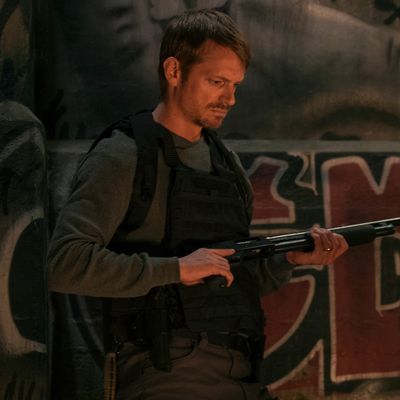
This review was originally published on December 1. We are recirculating it now timed to Silent Night’s digital release.
John Woo’s latest, Silent Night, is being billed as his first Hollywood film in more than 15 years, and at first glance, it looks like it could even represent a return to the poetically charged, operatic gunplay of his Hong Kong golden age. It opens with a feverishly stylized chase through a back alley as a desperate man in an ill-fitting Christmas sweater (Joel Kinnaman) does single-handed combat against cars filled with men armed to the teeth who are themselves in the middle of a gang war. The cars split open and spin in slow motion in the air. Windshields explode. Bullets fly everywhere. A red balloon drifts, quietly, above and away from the mayhem. Then, our supposed hero gets shot in the throat and all is blackness.
But Silent Night turns out to be something very different from anything Woo has done before. Its central gimmick is that Kinnaman’s Brian Godlock, the wounded protagonist, has been deprived of his voice, so the film has no spoken dialogue in it. (There are, however, snatches of text messages that appear onscreen as well as the occasional angry scrawl or radio broadcast, so it’s not entirely word-free.) This sets up Woo to tell his story visually, but it also establishes the emotional conceit of the movie. Brian’s young son was killed by a stray bullet from that aforementioned gang war; in his rage, Brian ran after the cars, and now, with his injury, he’s been deprived of any ability to express himself. Kinnaman, an actor who once seemed set for big things but never quite found his way into a genuine hit, makes this man’s voicelessness palpable. Watching him stand in front of a mirror, trying to scream, we connect with his impotence.
The lack of dialogue does seem to have rejuvenated Woo. Although the central gimmick derives from the fact that Brian has lost his voice, the picture doesn’t pretend to depict a world where people don’t talk. (Unlike, say, Luc Besson’s 1984 film Le Dernier Combat, which worked a similar idea.) Instead, whenever it looks like someone might speak, Woo inserts formal devices such as freeze-frames to stitch things over. This also places us deeper into Brian’s psyche. We are watching not so much a world where people don’t talk, but rather a world where people don’t want to hear each other talk.
Brian rejects attempts by his wife (the wonderfully expressive Catalina Sandino Moreno) to communicate, plunging further into his vengeful gloom, working out incessantly and teaching himself how to fight via YouTube tutorials. We’ve seen countless training montages in movies over the years, though I’m not sure they’ve ever been this grim and relentless. Woo keeps these scenes going to an almost pathological degree. It’s more Taxi Driver than Rocky. The point is not that the bad guys are about to get theirs. The point is that our hero has lost his mind.
Though Silent Night is awash in style, this is not the “heroic bloodshed” of Woo’s golden years, nor is it the gonzo, over-the-top action melodrama of his American period. In most of those films, there was an iconic, almost aspirational quality to the mayhem. Woo reminded us of how fun movie violence could be when done with flair. And he knew how to make an actor look great. He turned Chow Yun-fat into cinema’s coolest action figure. He turned Nicolas Cage’s psycho antics in Face/Off into a walking manifesto of magnificent weirdness. (He so overdid it with Tom Cruise in Mission: Impossible 2 that it actually kind of backfired; Cruise looked too good.) For all the butchery on display, we wanted to be these people. It was a lesson the director had learned from the American cinema of his youth, and American cinema borrowed the influence back from him in the 1990s.
But Woo isn’t having fun in Silent Night. There’s nothing to aspire to, among either the good guys or the bad guys. Though Silent Night will surely come under fire (justifiable, to some extent) for being yet another white-guy-revenge fantasy, there’s no actual fantasy here. The film doesn’t have the simmering, anticipatory comeuppance of a Death Wish or one of its many vigilante imitators. Brian’s grief never deserts him the way it might had it been a mere plot device. Instead, it colors everything he does. Woo constantly cuts back, either to the death of the child or to happy memories and projections, which are also little stabs of unimaginable pain in the character’s mind. The more Brian fights and kills, the less he’s able to move on.
Understandably, then, the film’s action sequences, while certainly intense and elaborately choreographed, are never ecstatic in the way Woo’s sequences have been in the past. Indeed, if Silent Night reads as an actual comment on anything, it’s that of what happens when an ordinary family finds itself in the middle of a John Woo movie. The armed men of the film’s inciting incident are precisely the cartoonish, multi-gun-wielding foot soldiers that populated earlier efforts. The director has always been an earnest, emotional guy, and while he’s never been apologetic about his earlier work (why should he?), he has expressed some regret over the years that his films have occasionally bred copycat crimes. Silent Night at times feels like a dark dream he might have had over the consequences of all that violence. It’s all garish, nightmarish spectacle — beautiful, terrifying, and poisonous.
More Movie Reviews
- The Thriller Drop Is a Perfect Addition to the Bad-First-Date Canon
- The Accountant 2 Can Not Be Taken Seriously
- Another Simple Favor Is So Fun, Until It Gets So Dumb


